Abstract
The differential dihydrofunctionalization of terminal alkynes is accomplished through the reductive three-component coupling of terminal alkynes, aryl halides and pinacolborane. The transformation results in hydrofunctionalization of both π bonds of an alkyne in a single reaction promoted by cooperative action of a copper/palladium catalyst system. The differential dihydrofunctionalization reaction has excellent substrate scope and can be accomplished in the presence of esters, nitriles, alkyl halides, epoxides, acetals, alkenes, aryl halides, and silyl ethers. Mechanistic experiments indicate that the reaction proceeds through copper-catalyzed hydroboration followed by a second hydrocupration. The resulting heterobimetallic complex is the key intermediate that participates in subsequent palladium-catalyzed cross coupling, which furnishes benzylic alkyl boronate products.
Alkynes are extensively used in organic synthesis as readily available and versatile intermediates. They participate in a wide range of transformations, the most common of which are C-H functionalization of terminal alkynes, addition to one of the π bonds, and a double addition to both π bonds. Also known, but significantly less common, are reactions that lead to the differential transformation of the two π bonds. One of the simplest and oldest1 reactions that mechanistically fits this description is the hydration of alkynes, which involves initial hydration followed by a tautomerization.2,3 This transformation has been known for a long time, and has inspired development of differential transformations of alkyne π bonds using other hydrofunctionalization reactions. However, these transformations are still rare,4 and generally rely on intramolecular reactions5 or reactions of alkynes activated by electron-withdrawing groups.6
Our interest in copper-catalyzed hydrofunctionalization reactions7 led us to explore the application of copper hydride chemistry8 in differential functionalization of the two alkyne π bonds. Successful applications developed so far have combined copper-catalyzed hydrofunctionalization of one π bond with catalytic reduction of the other (Scheme 1a).9 In 2014, Buchwald et al. reported the first example of such a reductive hydrofunctionalization reaction, which combines reduction and hydroamination.10 More recently, Mankad et al. reported an interesting example of a hydroacylation reaction followed by a reduction.11
Scheme 1.
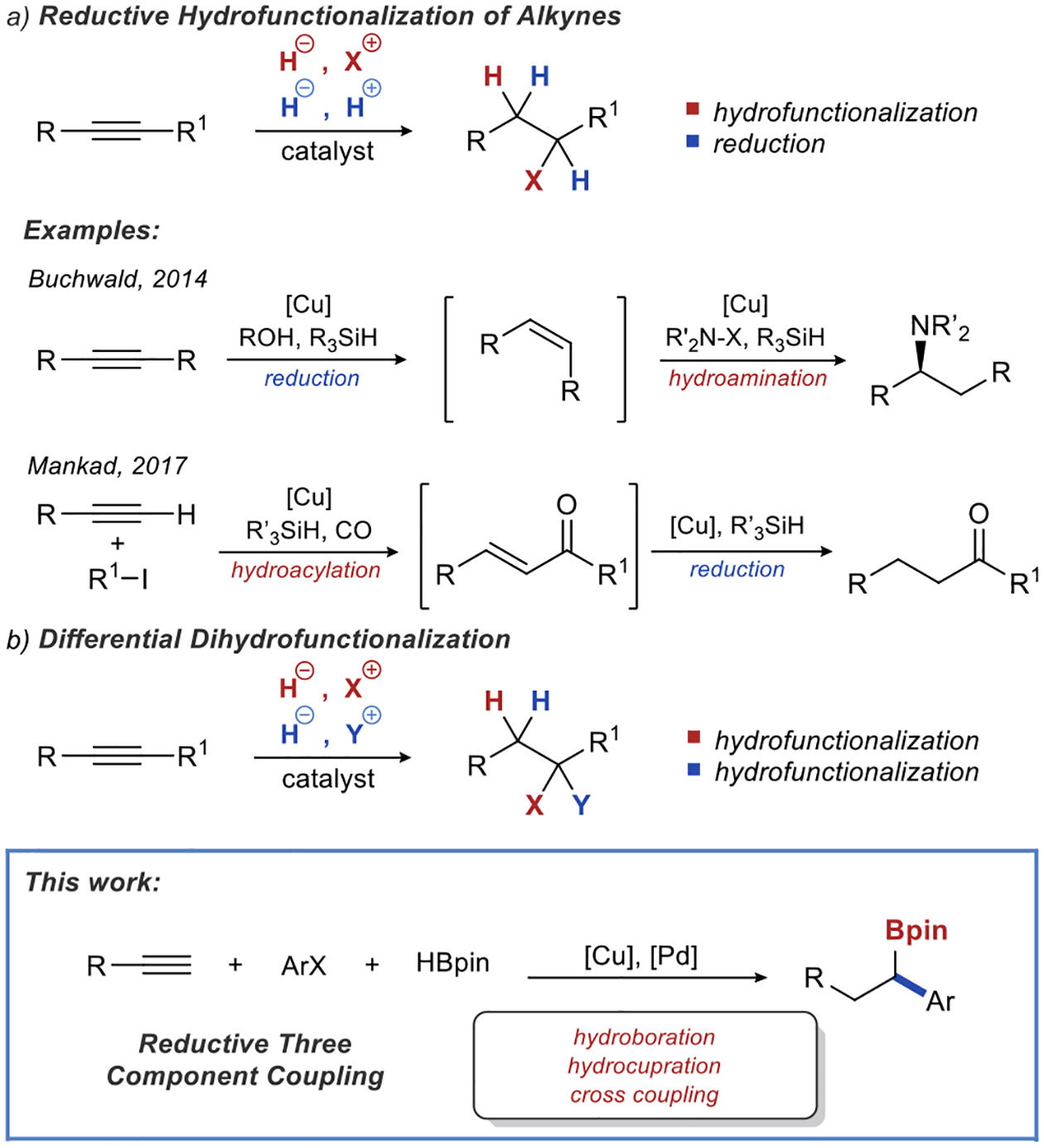
Copper Hydride Chemistry in Differential Functionalization of Alkyne π Bonds.
The methods developed by the Buchwald and Mankad groups demonstrate the utility of copper hydride chemistry in differential transformations of alkyne π bonds. They also suggest a great potential for the development of reactions that would combine copper-catalyzed hydrofunctionalization of one π bond with a different hydrofunctionalization of the other π bond (Scheme 1b). Such reactions would significantly increase the complexity of the products that can be accessed directly from alkynes and would enhance their utility as synthetic intermediates.
In this paper, we describe a method for the differential dihydrofunctionalization of terminal alkynes that formally combines hydroboration with hydroarylation (Scheme 1b). The overall reaction, promoted by synergistic Cu/Pd catalysis, results in reductive coupling of terminal alkynes, aryl bromides, and pinacolborane and the formation of benzylic alkyl boronates.12
Inspiration for our approach to differential dihydrofunctionalization came from a report by Sadighi et al. in 2006.13 The authors describe the hydrocupration of alkenyl Bpin by IPrCuH and formation of a heterobimetallic complex (eq 1).
 |
(1) |
While we7,14 and others15 have previously established that (NHC)copper hydride complexes are excellent catalysts for hydrofunctionalization of alkynes,8 this report demonstrated that these same complexes also participate in the selective hydrocupration of functionalized alkenes.16 Our plan was to combine these two facets of the (NHC)CuH chemistry and develop a differential dihydrofunctionalization of alkynes (Scheme 2).
Scheme 2.
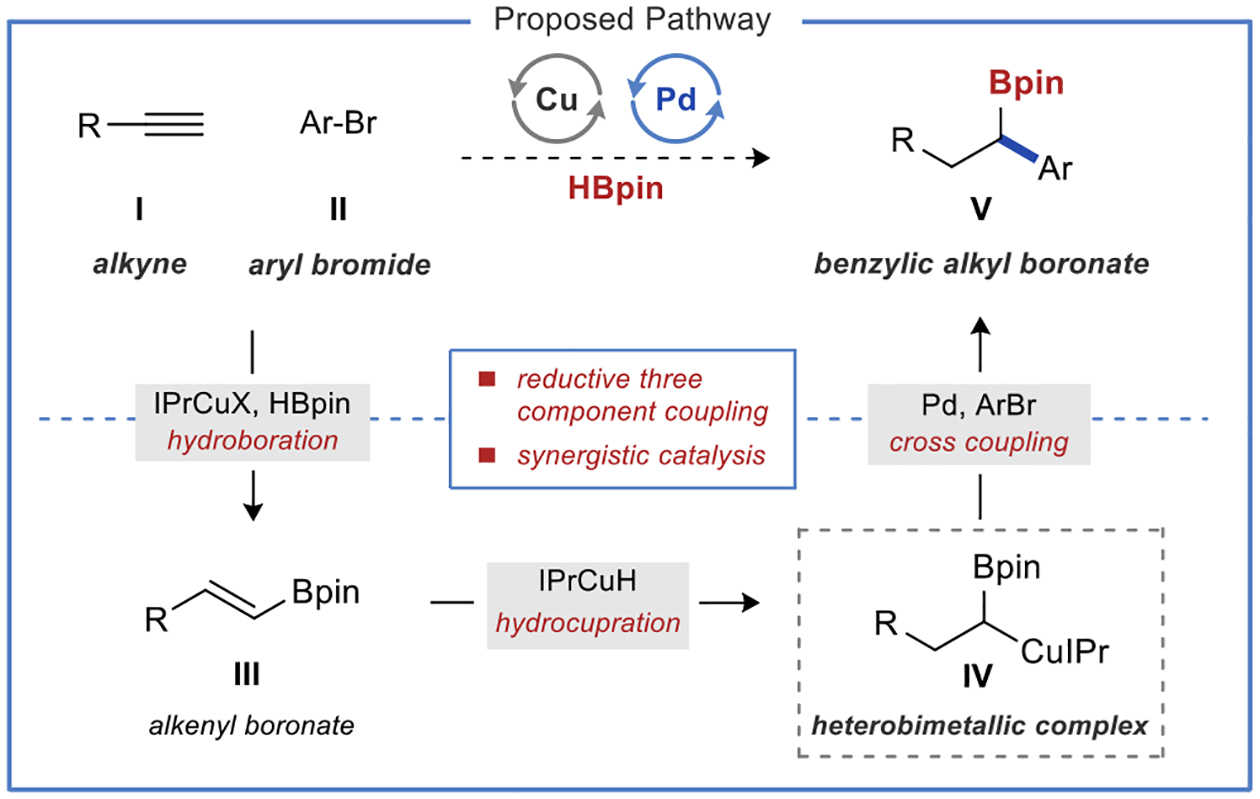
Design of Differential Dihydrofunctionalization
We reasoned that the heterobimetallic intermediate IV could be accessed directly from alkynes through copper-catalyzed hydroboration and the subsequent hydrocupration of the alkenyl boronate ester (III). This simple access to the heterobimetallic intermediate provides an opportunity to systematically explore a wide range of differential dihydrofunctionalization reactions of alkynes through further functionalization of this key intermediate. We chose to pursue palladium-catalyzed cross coupling of the heterobimetallic intermediate (IV) with aryl bromides (II), inspired by known catalytic arylations of related copper(I) alkyl intermediates.17
Preliminary investigation of the proposed differential dihydrofunctionalization reaction began with 5-phenyl-1-pentyne (1), 4-bromoanisole (2) and pinacolborane as coupling partners, with IPrCuOt-Bu and a variety of palladium catalysts. Initially, we observed numerous reactions promoted by the Cu/Pd catalyst system. In addition to the desired product (3), products of Miyaura borylation18 (4), hydroboration15b,19 (5), hydroarylation20 (6) and geminal diboration21 (7) of the alkyne were also observed (Scheme 3).
Scheme 3.
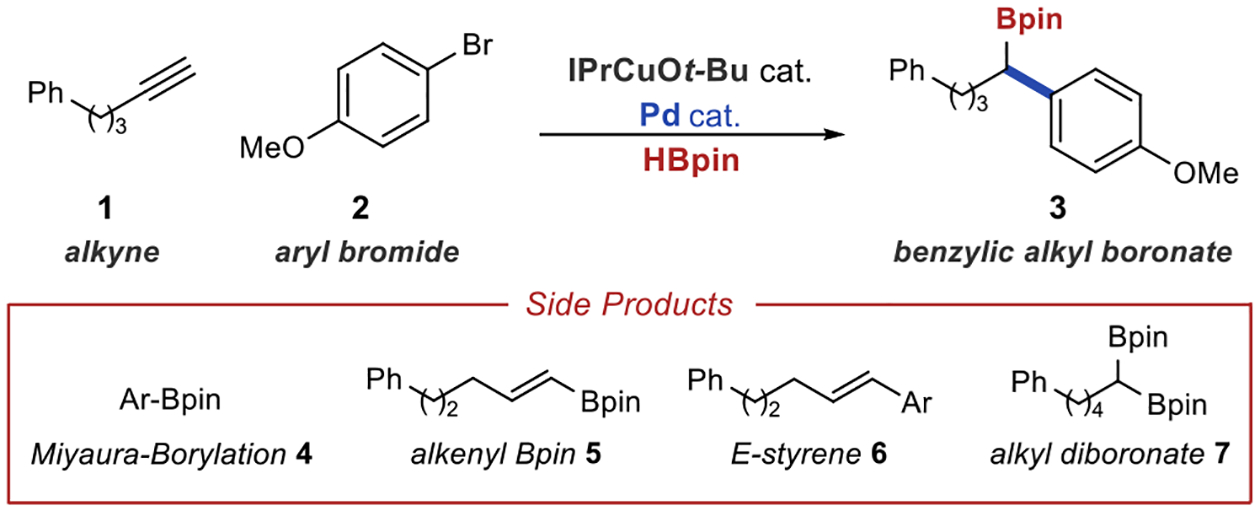
Preliminary Investigation of Differential Dihydrofunctionalization
In addition to alkenyl boronate 5, compounds 622 and 712b could, in principle, also serve as intermediates in the synthesis of the desired product 3. However, careful monitoring of the reaction mixture revealed that the formation of either the E-styrene (6) or alkyl diboronate (7) generally corresponded with a decreased yield of the desired product (3). On the other hand, any alkenyl boronate (5) formed was consumed over the course of the reaction, resulting in the corresponding increase in yield of the desired product. As a result, we focused on identifying reaction conditions that would minimize both hydroarylation and diboration of the terminal alkyne.
Initially, we found that the identity of the palladium catalyst and the alkoxide additive had the greatest effect on the product distribution. Extensive reaction development focused on these two parameters led to an efficient differential dihydrofunctionalization of terminal alkynes shown in Table 1 (entry 1).
Table 1.
Reaction Development
 | ||
|---|---|---|
| Entry | deviation from above | yielda |
| 1 | none | 86 |
| 2 | Pd(OAc)2 instead of Pd2dba3 | 54 |
| 3 | IPrCuCI instead of IPrCuOt-Bu | 67 |
| 4 | 10 mol% IPrCuOt-Bu instead of 20 mol% | 31 |
| 5 | 2.5 mol% Pd2dba3 instead of 1.25 mol% | 59 |
| 6 | BrettPhos instead of XPhos | 20 |
| 7 | (R)-DTBM-SEGPHOS instead of IPr | 8 |
| 8 | NaOt-Bu instead of KOt-Bu | 46 |
| 9 | LiOt-Bu instead of KOt-Bu | 34 |
| 10 | benzene instead of toluene | 65 |
| 11 | isooctane instead of toluene | 24 |
| 12 | 1,4-dioxane instead of toluene | 5 |
| 13 | THF instead of toluene | 0 |
| 14 | 0.1 M instead of 0.05 Mb | 74 |
Α11 reactions performed on 0.05 mmol scale and monitored by GC with 1,3,5-trimethoxybenzene as an internal standard.
Concentration of alkyne in the reaction mixture. EPr 1,3-bis(2,6-diisopropylphenyl)imidazol-2-ylidene, dba = dibenzylideneacetone, pin = pinacolato.

During the reaction development, we made several observations summarized in Table 1. Considering that Pd2dba323 is rarely used in combination with dialkylbiaryl phosphine ligands, we were surprised that it was a significantly better precatalyst than other common palladium sources. For example, Pd(OAc)2 provided the product in only 54% yield at the full conversion (Table 1 entry 2) (see SI for further details). IPrCuOt-Bu performed better than IPrCuCl as a catalyst precursor (entry 3). Catalyst loading of both palladium and copper proved crucial. Lower loading of IPrCuOt-Bu resulted in decreased yield with full consumption of aryl halide (entry 4). Higher loading of the palladium catalyst increased formation of E-styrene (6) and lowered product yield (entry 5).
The reaction outcome was also greatly influenced by the choice of phosphine ligand. XPhos24 provided significantly higher selectivity for the desired product than closely related BrettPhos25 (entry 6) and other dialkylbiaryl ligands (see SI for details). Bisphosphine ligands like (R)-DTBM-SEGPHOS, formed the product of diboration (7) almost exclusively (entry 7). The choice of the alkoxide additive also proved important. KOt-Bu was superior to both NaOt-Bu and LiOt-Bu (entry 8 and 9), increasing conversion of alkenyl Bpin (5) to product, while suppressing formation of E-styrene (6).
High yields of the differentially dihydrofunctionalized product were obtained in aromatic hydrocarbon solvents such as toluene and benzene (entries 1 and 10), with lower yields in isooctane (entry 11) and minimal reactivity in ethereal solvents (entries 12 and 13) (see SI for details). Lastly, we observed that the concentration of the reaction mixture had a significant effect on yield. Doubling the concentration of the reaction mixture (entry 14) decreased the yield.26
Having established the conditions for the differential dihydrofunctionalization of terminal alkynes (Table 1, entry 1), we explored the scope of the reaction (Table 2). A broad range of aryl bromides serve as coupling partners. Both electron-rich (3 and 11) and electron-poor (8 and 12) aryl bromides were viable coupling partners. A variety of functional groups were tolerated, and reaction could be performed in the presence of aryl fluorides (9), aryl chlorides (10) and acetals (13 and 24). Styrenes (18) were also compatible with the reaction. Products derived from para (14), meta- (15) and ortho- (16) substituted aryl bromides were isolated in good yields. Notably, a variety of O, N and S containing heterocycles were compatible with this reaction (19 – 23).
Table 2.
Scope of Differential Dihydrofunctionalization of Alkynes

|
Reactions run on 0.5 mmol scale.
IPrCuCl instead of IPrCuOt-Bu and NaOt-Bu instead of KOt-Bu.
toluene:isooctane (1:1) used.
GC yield, with 1,3,5-trimethoxybenzene as internal standard.
KOTMS used instead of KOt-Bu and toluene:THF (1:1) was used. Ar1 = 4-OMe(C6H4), Ar2 = 4-CF3(C6H4)
We also explored the scope of the alkyne coupling partner. Alkynes containing nitriles (25), epoxides (27), chlorides (29), bromides (30), acetals (35) and esters (36) were compatible with the reaction conditions. Protected alcohols (28, 31 and 32) and functionalized phenyl ethers (26, 40 and 41) were competent coupling partners in the reaction. Propargylic substitution of the alkyne also provided products in good yields (32 – 34). Finally, electron rich (38) and electron deficient (39) aryl acetylenes can be utilized in this reaction.
We also noted several limitations of the reaction. The reaction is not compatible with aldehydes, ketones, activated alkenes (such as enones), free alcohols, or tertiary alkyl amines. Furthermore, reactions with several aryl chlorides provided no desired products, suggesting that aryl chlorides are not viable substrates. Finally, internal alkynes, including differentially substituted aryl alkyl alkynes provided no desired product in the reaction.
Considering our preliminary observations and the known reactivity of both palladium-catalyzed cross coupling27 and copper-catalyzed hydrofunctionalization reactions,8 we envisioned three possible pathways for differential dihydrofunctionalization of terminal alkynes (eq. 2): a) copper-catalyzed hydroboration followed by hydrocupration and electrophilic functionalization, b) hydroarylation followed by hydroboration, or c) diboration to generate the alkyl diboronate, followed by mono-selective cross coupling with the aryl halide. Each pathway proceeds through a unique intermediate: a) alkenyl Bpin (5), b) E-styrene (6) or c) alkyl diboronate (7).
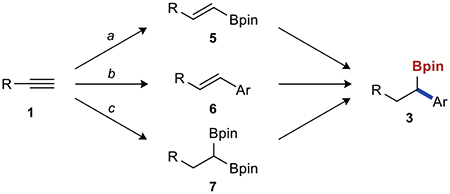 |
(2) |
We explored the reactivity of each presumed intermediate under the standard conditions for differential dihydrofunctionalization (Scheme 4). When alkenyl Bpin (5) was the substrate, the desired product (3) was formed in 43% yield after 6 h (Scheme 4a), whereas neither E-styrene (6), nor alkyl diboronate (7) formed the desired product in appreciable yields even after 24 h (Scheme 4b and c). In both cases, products of other side reactions were observed and/or starting material was recovered. These results strongly suggest that the operative pathway involves hydroboration of the alkyne (eq 2, a).
Scheme 4.
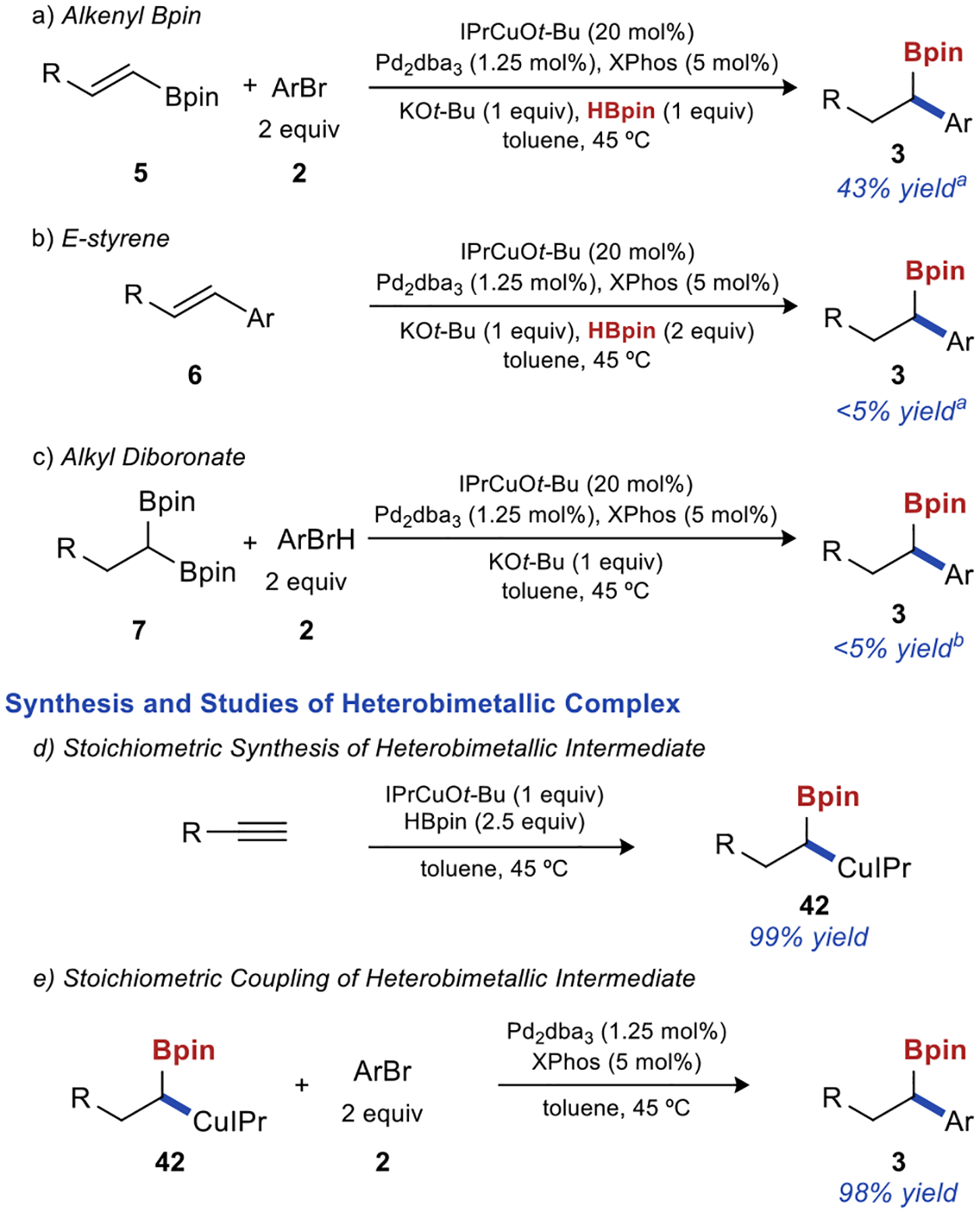
Mechanistic Experiments
We also wanted to verify that the heterobimetallic complex (IV) could be formed directly from terminal alkynes and is the key catalytic intermediate in the reaction. The stoichiometric reaction between terminal alkyne, IPrCuOt-Bu, and HBpin resulted in the formation of hetermobimetallic complex 42, in excellent yield (Scheme 4d). Additionally, the stoichiometric cross coupling between 42 and aryl bromide (2) yielded the desired benzylalkylboronate in 98% yield (Scheme 4e). Altogether, these results support our proposed pathway.
Considering the results of these experiments, we propose the mechanism outlined in Scheme 5. Initial transmetallation between IPrCuOt-Bu and HBpin generates IPrCuH, and hydrocupration of the terminal alkyne (I) results in alkenyl copper (VI). Additional transmetallation between a second equivalent of HBpin and VI delivers alkenyl Bpin (III) and regenerates IPrCuH. Reinsertion of III into IPrCuH furnishes heterobimetallic complex (IV).
Scheme 5.
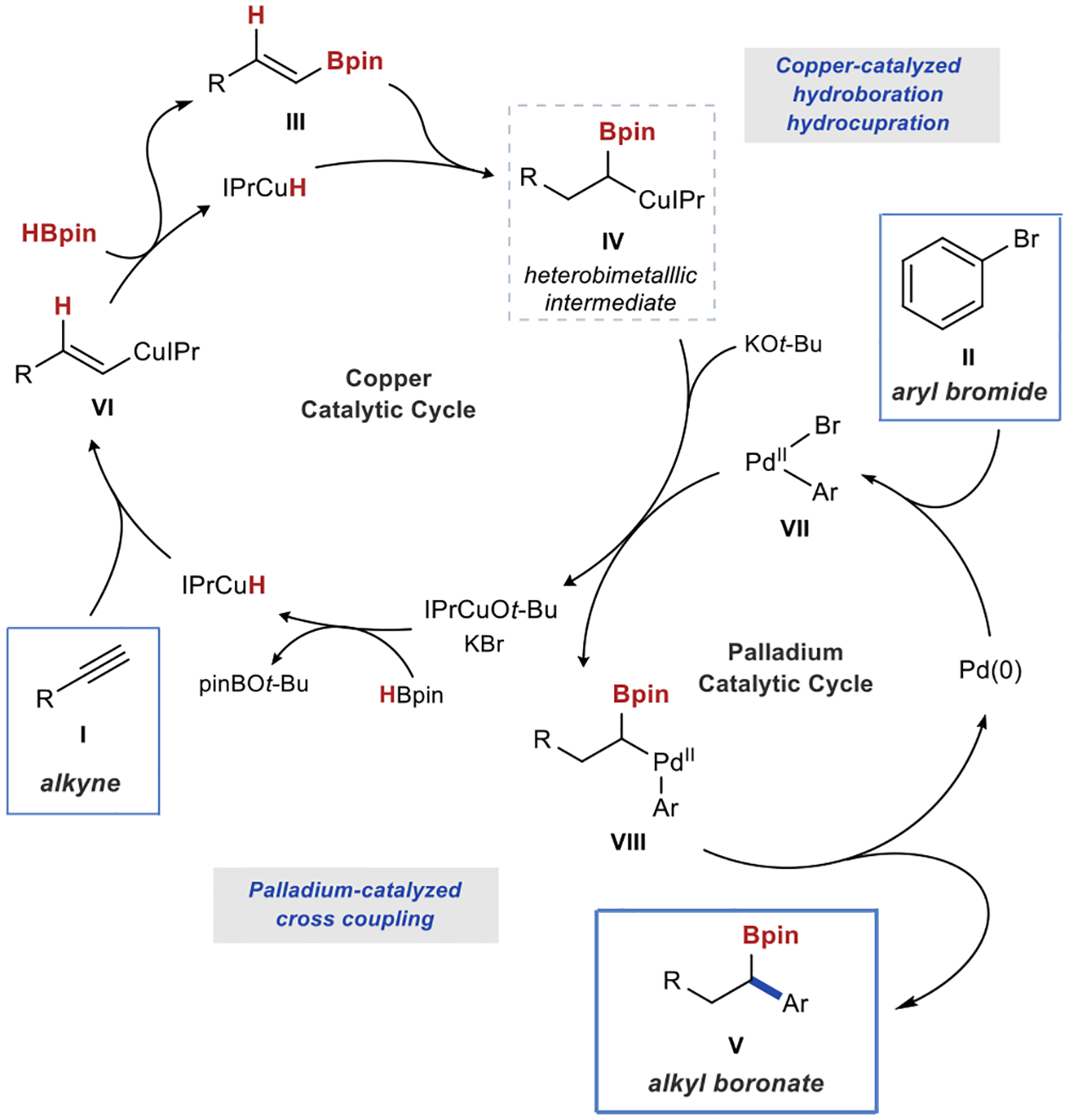
Proposed Catalytic Cycle
The heterobimetallic complex (IV) participates in a standard palladium-catalyzed cross coupling with the aryl bromide to produce the differentially dihydrofunctionalized product V and Pd(0). IPrCuOt-Bu catalyst is regenerated in the presence of KOt-Bu.
In conclusion, we have developed a method for the differential dihydrofunctionalization of alkynes that results in the reductive three-component coupling of terminal alkynes, aryl bromides, and pinacolborane. The benzylic alkyl boronate products are accessed directly from terminal alkynes by accomplishing two different regioselective hydrofunctionalization reactions promoted by a Cu/Pd catalyst system.
The reaction has excellent substrate scope and functional group compatibility, providing the desired products in high yields. The results of mechanistic experiments indicate that the reaction proceeds through copper-catalyzed hydroboration, followed by a second hydrocupration of the alkenyl boronate, and palladium-catalyzed arylation of the resulting heterobimetallic intermediate. The most important finding of our studies is that the heterobimetallic intermediate can be readily accessed directly from the terminal alkyne in the presence of a copper catalyst and HBpin. We believe that the access to this heterobimetallic intermediate provides an exciting opportunity for a systematic development of other differential dihydrofunctionalization reactions.
Supplementary Material
ACKNOWLEDGEMENT
We thank Prof. Forrest Michael for assistance in preparation of this manuscript. We also thank NIH for financial support.
Funding Sources
NIH (1R01GM125791-01A1) is acknowledged.
Footnotes
Supporting Information.
The Supporting Information is available free of charge on the dure and product characterizatio ACS Publications website. Experimental procedure and product characterization
The authors declare no competing financial interest.
REFERENCES
- (1).Neumann B; Schneider H Die Überführung Von Acetylen in Acetaldehyd Und Essigsäure. Angew. Chem 1920, 33, 189. [Google Scholar]
- (2).a) Halpern J; James BR; Kemp ALW Catalysis of the Hydration of Acetylenic Compounds by Ruthenium(III) Chloride. J. Am. Chem. Soc 1961, 83, 4097; [Google Scholar]; b) Halpern J; James BR; Kemp ALW Formation and Properties of Some Chlorocarbonyl Complexes of Ruthenium(II) and Ruthenium(III). J. Am. Chem. Soc 1966, 88, 5142; [Google Scholar]; c) Blum J; Huminer H; Alper H Alkyne Hydration Promoted by RhCl3 and Quaternary Ammonium Salts. J. Mol. Catal 1992, 75, 153; [Google Scholar]; d) Hiscox W; Jennings PW Catalytic Hydration of Alkynes with Zeise’s Dimer. Organometallics 1990, 9, 1997; [Google Scholar]; e) Baidossi W; Lahav M; Blum J Hydration of Alkynes by a PtCl4–Co Catalyst. J. Org. Chem 1997, 62, 669. [DOI] [PubMed] [Google Scholar]
- (3).For examples of anti-Markovnikov hydration of alkynes, see:; a) Tokunaga M; Wakatsuki Y The First Anti-Markovnikov Hydration of Terminal Alkynes: Formation of Aldehydes Catalyzed by a Ruthenium(II)/Phosphane Mixture. Angew. Chem. Int. Ed 1998, 37, 2867; [DOI] [PubMed] [Google Scholar]; b) Grotjahn DB; Lev DA A General Bifunctional Catalyst for the Anti-Markovnikov Hydration of Terminal Alkynes to Aldehydes Gives Enzyme-Like Rate and Selectivity Enhancements. J. Am. Chem. Soc 2004, 126, 12232. [DOI] [PubMed] [Google Scholar]
- (4).Zeng X Recent Advances in Catalytic Sequential Reactions Involving Hydroelement Addition to Carbon–Carbon Multiple Bonds. Chem. Rev 2013, 113, 6864. [DOI] [PubMed] [Google Scholar]
- (5).a) Utimoto K Palladium Catalyzed Synthesis of Heterocycles. Pure Appl. Chem 1983, 55, 1845; [Google Scholar]; b) Messerle BA; Vuong KQ Rhodium- and Iridium-Catalyzed Double Hydroalkoxylation of Alkynes, an Efficient Method for the Synthesis of O,O-Acetals: Catalytic and Mechanistic Studies. Organometallics 2007, 26, 3031; [Google Scholar]; c) Belting V; Krause N Gold-Catalyzed Tandem Cycloisomerization–Hydroalkoxylation of Homopropargylic Alcohols. Org. Lett 2006, 8, 4489; [DOI] [PubMed] [Google Scholar]; d) Barluenga J; Fernández A; Satrústegui A; Diéguez A; Rodríguez F; Fañanás FJ Tandem Intramolecular Hydroalkoxylation–Hydroarylation Reactions: Synthesis of Enantiopure Benzofused Cyclic Ethers from the Chiral Pool. Chem. Eur. J 2008, 14, 4153; [DOI] [PubMed] [Google Scholar]; e) Barluenga J; Fernández A; Diéguez A; Rodríguez F; Fañanás FJ Gold- or Platinum-Catalyzed Cascade Processes of Alkynol Derivatives Involving Hydroalkoxylation Reactions Followed by Prins-Type Cyclizations. Chem. Eur. J 2009, 15, 11660; [DOI] [PubMed] [Google Scholar]; f) Bhuvaneswari S; Jeganmohan M; Cheng C-H Platinum-Catalyzed Multistep Reactions of Indoles with Alkynyl Alcohols. Chem. Eur. J 2007, 13, 8285; [DOI] [PubMed] [Google Scholar]; g) Patil NT; Raut VS; Kavthe RD; Reddy VVN; Raju PVK Thorpe–Ingold Effect in Copper(II)-Catalyzed Formal Hydroalkoxylation–Hydroarylation Reaction of Alkynols with Indoles. Tetrahedron Lett. 2009, 50, 6576; [Google Scholar]; h) Shibuya M; Fujita S; Abe M; Yamamoto Y Brønsted Acid/Silane Catalytic System for Intramolecular Hydroalkoxylation and Hydroamination of Unactivated Alkynes. ACS Catal. 2017, 7, 2848; [Google Scholar]; i) Shibuya M; Okamoto M; Fujita S; Abe M; Yamamoto Y Boron-Catalyzed Double Hydrofunctionalization Reactions of Unactivated Alkynes. ACS Catal 2018, 8, 4189; [Google Scholar]; j) Li X; Chianese AR; Vogel T; Crabtree RH Intramolecular Alkyne Hydroalkoxylation and Hydroamination Catalyzed by Iridium Hydrides. Org. Lett 2005, 7, 5437; [DOI] [PubMed] [Google Scholar]; k) Yang T; Campbell L; Dixon DJ A Au(I)-Catalyzed N-Acyl Iminium Ion Cyclization Cascade. J. Am. Chem. Soc 2007, 129, 12070. [DOI] [PubMed] [Google Scholar]
- (6).a) Sriramurthy V; Barcan GA; Kwon O Bisphosphine-Catalyzed Mixed Double-Michael Reactions: Asymmetric Synthesis of Oxazolidines, Thiazolidines, and Pyrrolidines. J. Am. Chem. Soc 2007, 129, 12928; [DOI] [PMC free article] [PubMed] [Google Scholar]; b) Sriramurthy V; Kwon O Diphosphine-Catalyzed Mixed Double-Michael Reaction: A Unified Synthesis of Indolines, Dihydropyrrolopyridines, Benzimidazolines, Tetrahydroquinolines, Tetrahydroisoquinolines, Dihydrobenzo-1,4-Oxazines, and Dihydrobenzo-3,1-Oxazines. Org. Lett 2010, 12, 1084. [DOI] [PMC free article] [PubMed] [Google Scholar]
- (7).a) Uehling MR; Suess AM; Lalic G Copper-Catalyzed Hydroalkylation of Terminal Alkynes. J. Am. Chem. Soc 2015, 137, 1424; [DOI] [PubMed] [Google Scholar]; b) Uehling MR; Rucker RP; Lalic G Catalytic Anti-Markovnikov Hydrobromination of Alkynes. J. Am. Chem. Soc 2014, 136, 8799; [DOI] [PubMed] [Google Scholar]; c) Mailig M; Hazra A; Armstrong MK; Lalic G Catalytic Anti-Markovnikov Hydroallylation of Terminal and Functionalized Internal Alkynes: Synthesis of Skipped Dienes and Trisubstituted Alkenes. J. Am. Chem. Soc 2017, 139, 6969. [DOI] [PubMed] [Google Scholar]
- (8).Jordan AJ; Lalic G; Sadighi JP Coinage Metal Hydrides: Synthesis, Characterization, and Reactivity. Chem. Rev 2016, 116, 8318. [DOI] [PubMed] [Google Scholar]
- (9).For selected examples of reductive hydrofunctionalizations of alkynes using other catalyst systems, see:; a) Li L; Herzon SB Regioselective Reductive Hydration of Alkynes to Form Branched or Linear Alcohols. J. Am. Chem. Soc 2012, 134, 17376; [DOI] [PubMed] [Google Scholar]; b) Li L; Herzon SB Temporal Separation of Catalytic Activities Allows Anti-Markovnikov Reductive Functionalization of Terminal Alkynes. Nat. Chem 2013, 6, 22; [DOI] [PubMed] [Google Scholar]; c) Zeng M; Herzon SB Synthesis of 1,3-Amino Alcohols, 1,3-Diols, Amines, and Carboxylic Acids from Terminal Alkynes. J. Org. Chem 2015, 80, 8604; [DOI] [PubMed] [Google Scholar]; d) Nayal OS; Thakur MS; Kumar M; Sharma S; Kumar N Tin-Catalyzed Selective Reductive Hydroamination of Alkynes for the Synthesis of Tertiary Amines. Adv. Synth. Catal 2016, 358, 1103; [Google Scholar]; e) Tsuchimoto T; Wagatsuma T; Aoki K; Shimotori J Indium-Catalyzed Reductive Alkylation of Pyrroles with Alkynes and Hydrosilanes: Selective Synthesis of β-Alkylpyrroles. Org. Lett 2009, 11, 2129; [DOI] [PubMed] [Google Scholar]; f) Tsuchimoto T; Kanbara M Reductive Alkylation of Indoles with Alkynes and Hydrosilanes under Indium Catalysis. Org. Lett 2011, 13, 912; [DOI] [PubMed] [Google Scholar]; g) Zeng M; Li L; Herzon SB A Highly Active and Air-Stable Ruthenium Complex for the Ambient Temperature Anti-Markovnikov Reductive Hydration of Terminal Alkynes. J. Am. Chem. Soc 2014, 136, 7058; [DOI] [PubMed] [Google Scholar]; h) Heutling A; Pohlki F; Bytschkov I; Doye S Hydroamination/Hydrosilylation Sequence Catalyzed by Titanium Complexes. Angew. Chem. Int. Ed 2005, 44, 2951. [DOI] [PubMed] [Google Scholar]
- (10).Shi S-L; Buchwald SL Copper-Catalysed Selective Hydroamination Reactions of Alkynes. Nat. Chem 2014, 7, 38. [DOI] [PMC free article] [PubMed] [Google Scholar]
- (11).Cheng L-J; Mankad NP Cu-Catalyzed Hydrocarbonylative C–C Coupling of Terminal Alkynes with Alkyl Iodides. J. Am. Chem. Soc 2017, 139, 10200. [DOI] [PubMed] [Google Scholar]
- (12).For a review describing the utility of these compounds, see:; a) Rygus JPG; Crudden CM Enantiospecific and Iterative Suzuki-Miyaura Cross-Couplings. J. Am. Chem. Soc 2017, 139, 18124. [DOI] [PubMed] [Google Scholar]; For selected example of synthesis of benzylic alkyl boronates, see:; b) Nelson HM; Williams BD; Miró J; Toste FD Enantioselective 1,1-Arylborylation of Alkenes: Merging Chiral Anion Phase Transfer with Pd Catalysis. J. Am. Chem. Soc 2015, 137, 3213; [DOI] [PMC free article] [PubMed] [Google Scholar]; c) Sun C; Potter B; Morken JP A Catalytic Enantiotopic-Group-Selective Suzuki Reaction for the Construction of Chiral Organoboronates. J. Am. Chem. Soc 2014, 136, 6534; [DOI] [PMC free article] [PubMed] [Google Scholar]; d) Feng X; Jeon H; Yun J Regio- and Enantioselective Copper(I)-Catalyzed Hydroboration of Borylalkenes: Asymmetric Synthesis of 1,1-Diborylalkanes. Angew. Chem. Int. Ed 2013, 52, 3989; [DOI] [PubMed] [Google Scholar]; e) Lee JCH; McDonald R; Hall DG Enantioselective Preparation and Chemoselective Cross-Coupling of 1,1-Diboron Compounds. Nat. Chem 2011, 3, 894. [DOI] [PubMed] [Google Scholar]
- (13).Laitar DS; Tsui EY; Sadighi JP Copper(I) β-Boroalkyls from Alkene Insertion: Isolation and Rearrangement. Organometallics 2006, 25, 2405. [Google Scholar]
- (14).Suess AM; Lalic G Copper-Catalyzed Hydrofunctionalization of Alkynes. Synlett 2016, 27, 1165. [Google Scholar]
- (15).a) Fujihara T; Xu T; Semba K; Terao J; Tsuji Y Copper-Catalyzed Hydrocarboxylation of Alkynes Using Carbon Dioxide and Hydrosilanes. Angew. Chem. Int. Ed 2011, 50, 523; [DOI] [PubMed] [Google Scholar]; b) Semba K; Fujihara T; Terao J; Tsuji Y Copper-Catalyzed Highly Regio- and Stereoselective Directed Hydroboration of Unsymmetrical Internal Alkynes: Controlling Regioselectivity by Choice of Catalytic Species. Chem. Eur. J 2012, 18, 4179. [DOI] [PubMed] [Google Scholar]
- (16).Jang WJ; Han JT; Yun J NHC-Copper-Catalyzed Tandem Hydrocupration and Allylation of Alkenyl Boronates. Synthesis 2017, 49, 4753. [Google Scholar]
- (17).a) Friis SD; Pirnot MT; Dupuis LN; Buchwald SL A Dual Palladium and Copper Hydride Catalyzed Approach for Alkyl–Aryl Cross-Coupling of Aryl Halides and Olefins. Angew. Chem. Int. Ed 2017, 56, 7242; [DOI] [PMC free article] [PubMed] [Google Scholar]; b) Logan KM; Brown MK Catalytic Enantioselective Arylboration of Alkenylarenes. Angew. Chem. Int. Ed 2017, 56, 851; [DOI] [PMC free article] [PubMed] [Google Scholar]; c) Bergmann AM; Dorn SK; Smith KB; Logan KM; Brown MK Catalyst-Controlled 1,2- and 1,1-Arylboration of α-Alkyl Alkenyl Arenes. Angew. Chem. Int. Ed 2019, 58, 1719; [DOI] [PMC free article] [PubMed] [Google Scholar]; d) Semba K; Ariyama K; Zheng H; Kameyama R; Sakaki S; Nakao Y Reductive Cross-Coupling of Conjugated Arylalkenes and Aryl Bromides with Hydrosilanes by Cooperative Palladium/Copper Catalysis. Angew. Chem. Int. Ed 2016, 55, 6275; [DOI] [PubMed] [Google Scholar]; e) Semba K; Nakao Y Arylboration of Alkenes by Cooperative Palladium/Copper Catalysis. J. Am. Chem. Soc 2014, 136, 7567. [DOI] [PubMed] [Google Scholar]
- (18).a) Ishiyama T; Murata M; Miyaura N Palladium(0)-Catalyzed Cross-Coupling Reaction of Alkoxydiboron with Haloarenes: A Direct Procedure for Arylboronic Esters. J. Org. Chem 1995, 60, 7508; [Google Scholar]; b) Billingsley KL; Buchwald SL An Improved System for the Palladium-Catalyzed Borylation of Aryl Halides with Pinacol Borane. J. Org. Chem 2008, 73, 5589. [DOI] [PMC free article] [PubMed] [Google Scholar]
- (19).a) Jang WJ; Lee WL; Moon JH; Lee JY; Yun J Copper-Catalyzed Trans-Hydroboration of Terminal Aryl Alkynes: Stereodivergent Synthesis of Alkenylboron Compounds. Org. Lett 2016, 18, 1390; [DOI] [PubMed] [Google Scholar]; b) Bai T; Yang Y; Han C Isolation and Characterization of Hydrocarbon Soluble NHC Copper(I) Phosphoranimide Complex and Catalytic Application for Alkyne Hydroboration Reaction. Tetrahedron Lett. 2017, 58, 1523; [Google Scholar]; c) Hall JW; Unson DML; Brunel P; Collins LR; Cybulski MK; Mahon MF; Whittlesey MK Copper-NHC-Mediated Semihydrogenation and Hydroboration of Alkynes: Enhanced Catalytic Activity Using Ring-Expanded Carbenes. Organometallics 2018, 37, 3102; [Google Scholar]; d) Lipshutz BH; Bošković ŽV; Aue DH Synthesis of Activated Alkenylboronates from Acetylenic Esters by CuH-Catalyzed 1,2-Addition/Transmetalation. Angew. Chem. Int. Ed 2008, 47, 10183. [DOI] [PubMed] [Google Scholar]
- (20).Armstrong MK; Goodstein MB; Lalic G Diastereodivergent Reductive Cross Coupling of Alkynes through Tandem Catalysis: Z- and E-Selective Hydroarylation of Terminal Alkynes. J. Am. Chem. Soc 2018, 140, 10233. [DOI] [PMC free article] [PubMed] [Google Scholar]
- (21).Lee S; Li D; Yun J Copper-Catalyzed Synthesis of 1,1-Diborylalkanes through Regioselective Dihydroboration of Terminal Alkynes. Chem. Asian J 2014, 9, 2440. [DOI] [PubMed] [Google Scholar]
- (22).Noh D; Chea H; Ju J; Yun J Highly Regio- and Enantioselective Copper-Catalyzed Hydroboration of Styrenes. Angew. Chem. Int. Ed 2009, 48, 6062. [DOI] [PubMed] [Google Scholar]
- (23).a) Amatore C; Jutand A; Meyer G; Atmani H; Khalil F; Chahdi FO Comparative Reactivity of Palladium(0) Complexes Generated in Situ in Mixtures of Triphenylphosphine or Tri-2-Furylphosphine and Pd(dba)2. Organometallics 1998, 17, 2958; [Google Scholar]; b) Zalesskiy SS; Ananikov VP Pd2(dba)3 as a Precursor of Soluble Metal Complexes and Nanoparticles: Determination of Palladium Active Species for Catalysis and Synthesis. Organometallics 2012, 31, 2302. [Google Scholar]
- (24).Huang X; Anderson KW; Zim D; Jiang L; Klapars A; Buchwald SL Expanding Pd-Catalyzed C–N Bond-Forming Processes: The First Amidation of Aryl Sulfonates, Aqueous Amination, and Complementarity with Cu-Catalyzed Reactions. J. Am. Chem. Soc 2003, 125, 6653. [DOI] [PubMed] [Google Scholar]
- (25).Fors BP; Watson DA; Biscoe MR; Buchwald SL A Highly Active Catalyst for Pd-Catalyzed Amination Reactions: Cross-Coupling Reactions Using Aryl Mesylates and the Highly Selective Monoarylation of Primary Amines Using Aryl Chlorides. J. Am. Chem. Soc 2008, 130, 13552. [DOI] [PMC free article] [PubMed] [Google Scholar]
- (26). Optimal concentration of various componetnts in the reaction mixture was achieved when alkyne concetration was 0.05 M. Further decrease in concentration of reaction components (0.01 M in alkyne) was found to lower the yield of the desired product, with full conversion of starting materials being achieved only after 72 hours.
- (27).a) Biffis A; Centomo P; Del Zotto A; Zecca M Pd Metal Catalysts for Cross-Couplings and Related Reactions in the 21st Century: A Critical Review Chem. Rev 2018, 118, 2249; [DOI] [PubMed] [Google Scholar]; b) Johansson Seechurn CCC; Kitching MO; Colacot TJ; Snieckus V Palladium-Catalyzed Cross-Coupling: A Historical Contextual Perspective to the 2010 Nobel Prize Angew. Chem. Int. Ed 2012, 51, 5062. [DOI] [PubMed] [Google Scholar]
Associated Data
This section collects any data citations, data availability statements, or supplementary materials included in this article.


